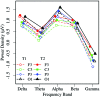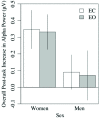Regional electroencephalogram (EEG) alpha power and asymmetry in older adults: a study of short-term test-retest reliability
- PMID: 26441639
- PMCID: PMC4584992
- DOI: 10.3389/fnagi.2015.00177
Regional electroencephalogram (EEG) alpha power and asymmetry in older adults: a study of short-term test-retest reliability
Abstract
Although regional alpha power and asymmetry measures have been widely used as indices of individual differences in emotional processing and affective style in younger populations, there have been relatively few studies that have examined these measures in older adults. Here, we examined the short-term test-retest reliability of resting regional alpha power (7.5-12.5 Hz) and asymmetry in a sample of 38 active, community-dwelling older adults (M age = 71.2, SD = 6.5 years). Resting electroencephalogram recordings were made before and after a perceptual computer task. Pearson and intra-class correlations indicated acceptable test-retest reliability for alpha power and asymmetry measures in all regions. Interestingly, alpha asymmetry appeared to be less affected by the task than was alpha power. Findings suggest that alpha asymmetry may reflect more enduring, "trait-like" characteristics, while alpha power may reflect more "state-like" processes in older adults.
Keywords: aging; alpha power; electroencephalogram (EEG); frontal asymmetry; psychophysiology; test–retest reliability.
Figures








Similar articles
-
Test-retest reliability of frontal alpha electroencephalogram (EEG) and electrocardiogram (ECG) measures in adolescents: a pilot study.Int J Neurosci. 2014 Dec;124(12):908-11. doi: 10.3109/00207454.2014.895003. Epub 2014 Apr 8. Int J Neurosci. 2014. PMID: 24617292
-
Frontal and parietal EEG alpha asymmetry: a large-scale investigation of short-term reliability on distinct EEG systems.Brain Struct Funct. 2022 Mar;227(2):725-740. doi: 10.1007/s00429-021-02399-1. Epub 2021 Oct 21. Brain Struct Funct. 2022. PMID: 34676455 Free PMC article.
-
Test-Retest Reliability of Frontal and Parietal Alpha Asymmetry during Presentation of Emotional Face Stimuli in Healthy Subjects.Neuropsychobiology. 2020;79(6):428-436. doi: 10.1159/000505783. Epub 2020 Mar 17. Neuropsychobiology. 2020. PMID: 32182618
-
Functional role of frontal electroencephalogram alpha asymmetry in the resting state in patients with depression: A review.World J Clin Cases. 2023 Mar 26;11(9):1903-1917. doi: 10.12998/wjcc.v11.i9.1903. World J Clin Cases. 2023. PMID: 36998965 Free PMC article. Review.
-
Individual differences in anterior EEG asymmetry: methodological problems and solutions.Biol Psychol. 2004 Oct;67(1-2):157-82. doi: 10.1016/j.biopsycho.2004.03.006. Biol Psychol. 2004. PMID: 15130530 Review.
Cited by
-
EEG resting-state functional connectivity: evidence for an imbalance of external/internal information integration in autism.J Neurodev Disord. 2022 Aug 27;14(1):47. doi: 10.1186/s11689-022-09456-8. J Neurodev Disord. 2022. PMID: 36030210 Free PMC article.
-
Electroencephalogram alpha asymmetry in geriatric depression : Valid or vanished?Z Gerontol Geriatr. 2018 Feb;51(2):200-205. doi: 10.1007/s00391-016-1108-z. Epub 2016 Jul 15. Z Gerontol Geriatr. 2018. PMID: 27422260 English.
-
Postural supporting cervical traction workstation to improve resting state brain activity in digital device users: EEG study.Digit Health. 2024 Sep 27;10:20552076241282244. doi: 10.1177/20552076241282244. eCollection 2024 Jan-Dec. Digit Health. 2024. PMID: 39351310 Free PMC article.
-
Effect of Forward Head Posture on Resting State Brain Function.Healthcare (Basel). 2024 Jun 7;12(12):1162. doi: 10.3390/healthcare12121162. Healthcare (Basel). 2024. PMID: 38921277 Free PMC article.
-
Abnormal Brain Oscillations in Developmental Disorders: Application of Resting State EEG and MEG in Autism Spectrum Disorder and Fragile X Syndrome.Front Neuroimaging. 2022 May 27;1:903191. doi: 10.3389/fnimg.2022.903191. eCollection 2022. Front Neuroimaging. 2022. PMID: 37555160 Free PMC article. Review.
References
LinkOut - more resources
Full Text Sources
Other Literature Sources

